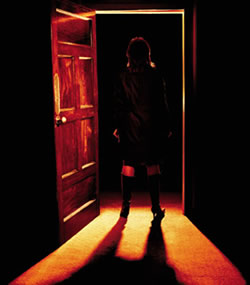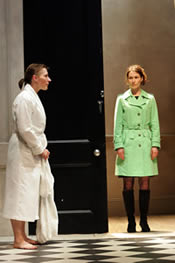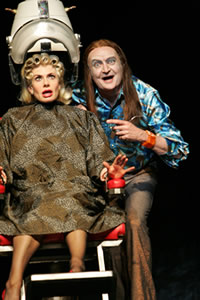
Bloody London:
A Report from the UK
By Caridad Svich
As the London theatre season makes West
End room for the bright new musical Billy Elliott and
a starry revival of Guys and Dolls with Ewan McGregor
and Jane Krakowski, other spaces in the city are presenting works
filled with menace and blood. At the Royal Court two new plays
are being showcased to fine advantage: David Eldridge's Incomplete
and Random Acts of Kindness and Roland Schimmelpfennig's
The Woman Before in a translation by David Tushingham.
Schimmelpfennig is a major contemporary German dramatist whose
work includes the acclaimed Arabian Night and Push
Up. While his plays are less known here in the U.S., it shouldn't
be long before they find homes at diverse American venues. His
writing--adroitly and cunningly translated by Tushingham--is witty,
stark, and mysterious.
The Woman Before, staged in the
Court's downstairs space by director Richard Wilson, is a story
of love gone wrong. A seemingly happily married man receives a
knock on the door by a former girlfriend he hasn't seen in 24
years. Bewildered by her appearance, the man (played by Nigel
Lindsay) tries to make nice with this demanding and forlorn stranger
from his past (played by Helen Baxendale), but in short scenes
that go back and forth in time during a single evening, it becomes
clear that this stranger cannot be easily dissuaded from her quest
to reclaim lost love. Vengeance of a very Greek kind is on her
mind, and the play begins to spin around the escalating manipulations
of a person triumphantly ruined by her obsessive love.
Schimmelpfennig plays out the alternately
tragic and absurdly comic story, which ends with scenes of bodies
being violated and burned, in shard-like scenes of increasing
intensity. The play is structured around the clock-like machinations
and disparate perspectives of a night of violence. What starts
innocently ends tragically. Yet what distinguishes this modern
Medea-influenced tale is the macabre precision Schimmelpfennig
brings to examining every moment of the fateful night.  His
refusal to settle his characters or his audience in a zone of
comfort is strangely upsetting and fitfully frustrating. Schimmelpfennig's
goal is to unsettle and provoke, and he is abetted by a suitably
restrained, disciplined cast, which also includes Saskia Reeves
as the man's wife, Robert Pattinson as their son and Georgia Taylor
as the son's girlfriend.
His
refusal to settle his characters or his audience in a zone of
comfort is strangely upsetting and fitfully frustrating. Schimmelpfennig's
goal is to unsettle and provoke, and he is abetted by a suitably
restrained, disciplined cast, which also includes Saskia Reeves
as the man's wife, Robert Pattinson as their son and Georgia Taylor
as the son's girlfriend.
For all this, at barely 80 minutes The
Woman Before is a bit slender and lacks the transcendence
of Schimmelpfennig's Arabian Night (produced by ATC/UK
in 2002). It nevertheless confirms his unique theatrical vision.
Violence also figures prominently in productions
playing at the Royal National Theatre and the Almeida. In the
RNT's Lyttelton Theatre can be found Improbable Theatre's inspired
adaptation of the 1973 cult horror film Theatre of Blood.
At the Almeida, director Rufus Norris stages Federico Garcia Lorca's
starkly tragic Blood Wedding in a colloquial and lean
new English translation by Tanya Ronder. Both productions feature
stars--the supremely gifted stage and screen actor Jim Broadbent
as Edward Lionheart in Theatre of Blood (the role originally
played by Vincent Price in the film) and Latino movie idol Gael
Garcia Bernal as Leonardo in Blood Wedding--yet neither
relies solely on them to carry the show.
Improbable Theatre has been making magical
and inventive pieces since 1986. Led by Phelim McDermott, Julian
Crouch and Lee Simpson, it has delighted audiences with 70
Hill Lane, Lifegame, and The Hanging Man, and later
this year it will bring the show Spirit to New York Theatre
Workshop. McDermott and Crouch are also responsible, along with
Cultural Industry, for the gloriously macabre junk opera Shockheaded
Peter. Working with small- and large-scale material, Improbable
has proved over time that its name is extremely apt, a token of
the leaders' insatiable curiosity about the theater. Theatre
of Blood fits the tradition perfectly.
Drafting a full script in advance for the
first time (rather than assembling it after improvisation), McDermott
and Simpson have fashioned a faithful version of the campy film
while also creating something new. Re-setting the story in a dis-used,
derelict theatre (brilliantly designed by Rae Smith), Improbable
opens with the image of Lionheart poised upon a ladder in the
midst of a grand theatrical gesture, surrounded by ghostly figures
from different eras of theatre history. This prelude is broken
by sound and light, suddenly the figures vanish, and all that
is left is the theatre space itself and the entrance of an unassuming
yet pretentious man dandily dressed in 1970s flare trousers, black
turtleneck and sporty tweed jacket. He is, we soon discover, a
theatre critic.
So the naughtily brilliant, rough-around-the-edges
mayhem begins. For those unfamiliar with the film, the story is
blunderingly simple and deliciously obvious: a Shakespearean actor
of dubious talent is not given the Critics Award at end of the
season and kills himself, or so it seems. What transpires instead
is that he takes up with a band of the undead and vows to seek
revenge on every critic who has given him a bad notice. The revenge
takes the form of murders modeled after famous scenes of dismemberment,
gouging and stabbing from Shakespeare's tragedies and histories.
The story follows the murders (each more extreme than the next),
until no critic is left standing and everyone is bathed in blood.
 By
casting Broadbent, one of the UK's most beloved comic actors,
McDermott ensures the audience's immediate engagement. Unlike
Vincent Price, who exuded a peculiar, somewhat effete menace,
Broadbent is all size, madness, and heart. What is terrifying
about him, despite the camp, is the melancholy vulnerability that
underlies his uncontrollable, obsessive streak of serial killings.
He is an actor wronged, and a human being destroyed by a desire
for positive acknowledgment from the very critics he purports
to despise. Broadbent embraces the paradox of the role with aplomb
and finesse. His fellow players, which include the esteemed Hayley
Carmichael, Bloolips Queer Theatre co-founder Bette Bourne, classical
actor Sally Dexter and the young Rachel Stirling (who plays the
role originated by her mother Diana Rigg in the film), all deliver
impeccably grand performances as well.
By
casting Broadbent, one of the UK's most beloved comic actors,
McDermott ensures the audience's immediate engagement. Unlike
Vincent Price, who exuded a peculiar, somewhat effete menace,
Broadbent is all size, madness, and heart. What is terrifying
about him, despite the camp, is the melancholy vulnerability that
underlies his uncontrollable, obsessive streak of serial killings.
He is an actor wronged, and a human being destroyed by a desire
for positive acknowledgment from the very critics he purports
to despise. Broadbent embraces the paradox of the role with aplomb
and finesse. His fellow players, which include the esteemed Hayley
Carmichael, Bloolips Queer Theatre co-founder Bette Bourne, classical
actor Sally Dexter and the young Rachel Stirling (who plays the
role originated by her mother Diana Rigg in the film), all deliver
impeccably grand performances as well.
Part of this production's charm has to
do with the puerile adolescent's intoxicating relish at shocking
an audience and indulging in sheer gore. With all of Improbable's
pieces (and this is true of Shockheaded Peter too) the
joy of what it took to make the work in the first place is always
present. You can sense from McDermott's zealous and overextended
approach to the story of Theatre of Blood the strangely
guilty pleasure he must have had watching the cult film when he
was a child. That the piece is at the National (as a co-production
with Improbable) makes it all the more irresistible. After all,
this is where GREAT plays have been staged season after season,
not rude, prankish, super-bloody, B-horror-flick adaptations!
The incongruity of the venue is sublime, especially in light of
the piece's innumerable theatrical references. It's as if Lincoln
Center had produced, with full resources and ingenuity, a production
of Whatever Happened to Baby Jane.
At the Almeida, Rufus Norris has followed
up his Festen (a critical triumph that will likely come
to Broadway this fall) with a death-ballad staging of Garcia Lorca's
Blood Wedding. Reducing the cast to thirteen, Norris
strips the play down to a few elements: a curtain, a wooden chair,
and a harness. The movement is sparse and the pace feverish. His
multi-ethnic cast (from Iceland, Mexico, Ireland, England, Netherlands,
Portugal, the Caribbean and India) spit their lines in bursts:
thoughts half-rendered, spoken aloud. It is always night, and
the color of the sky is vaginal red. Orlando Gough's music draws
from klezmer, Celtic folk songs, samba, and cabaret. There is
no interval and the show clocks in at 90-odd minutes.
 Although
Garcia Bernal is the box-office draw, he is not the production's
center. The focus is directorial, Norris's wrestling match with
this extraordinarily difficult, beautiful beast of a play. While
the lightning-speed approach is provocative--and certainly Lorca
invites Death to rule the dramatic world--I felt that Norris could
have trusted the play a bit more, let its tender and joyful side
blossom as much as its fiercely haunted fatalism. Even the wedding
scene is tinged with incessant despair, and the result is a one-sided
reading. In his attempt to wrest the piece from folkloric stereotypes
that often mar productions of Garcia Lorca's work, Norris has
gone too far in viewing the play as Thanatos's triumph over Eros
from the get-go. Nevertheless, the production demonstrates Norris's
ambition and intelligence as a director willing to go for broke
with his vision.
Although
Garcia Bernal is the box-office draw, he is not the production's
center. The focus is directorial, Norris's wrestling match with
this extraordinarily difficult, beautiful beast of a play. While
the lightning-speed approach is provocative--and certainly Lorca
invites Death to rule the dramatic world--I felt that Norris could
have trusted the play a bit more, let its tender and joyful side
blossom as much as its fiercely haunted fatalism. Even the wedding
scene is tinged with incessant despair, and the result is a one-sided
reading. In his attempt to wrest the piece from folkloric stereotypes
that often mar productions of Garcia Lorca's work, Norris has
gone too far in viewing the play as Thanatos's triumph over Eros
from the get-go. Nevertheless, the production demonstrates Norris's
ambition and intelligence as a director willing to go for broke
with his vision.
As for the performers, particular standouts
are Bjorn Haraldsson as the Groom and Rosaleen Linehan as the
Mother. Bernal is hard-working, if lacking a bit in power as the
betraying lover, but it's nice to see a star of his international
status taking a pay cut to work on a classic in a small venue
far from his native city.
Displacement and dissent mark two international
pieces--KUBA and The Story of Ronald, the Clown from
McDonald's--that live between the worlds of theatre and performance
art. The enterprising company Artangel, spearheaded by Michael
Morris, is presenting KUBA by Turkish artist Kutlag Ataman
in an abandoned sorting office just off of Bloomsbury. The area
known as Kuba emerged in Istanbul in the late 1960s as a neighborhood
of safe houses. Today it is comprised of a few hundred dwellings
that are home to non-conformists of various religions and ethnicities.
Accessed by several flights of stairs in the graffitti-marked
sorting office, the entrance to this multiple DVD installation
is a creaky institutional door that opens onto a vast room where
about twenty TV sets (different makes and models -- all old) play
edited testimonials of Kuba residents. Mostly shot in medium and
close-up, these videos tell stories of abuse, defiance and despair.
 Violence
weaves the stories together -- the violence of parents on children,
gang members on passersby, brother on brother. While presented
as an art installation, KUBA functions as virtual theater
of testimony due to its complex storytelling and emphasis on the
real. It's a remarkable installation that raises important questions
about the protection of dissidents and the recording and witnessing
of their stories.
Violence
weaves the stories together -- the violence of parents on children,
gang members on passersby, brother on brother. While presented
as an art installation, KUBA functions as virtual theater
of testimony due to its complex storytelling and emphasis on the
real. It's a remarkable installation that raises important questions
about the protection of dissidents and the recording and witnessing
of their stories.
Argentine-born, Madrid-based writer-director
Rodrigo Garcia has similar storytelling matters in mind in The
Story of Ronald, the Clown from McDonald's. Garcia brought
his aptly named La Carniceria Teatro (Slaughter Theatre) to the
Brighton Festival in May for the UK premiere of this imagistic,
highly physical, assaultive meditation on consumer culture and
globalization. Performed by three actors, The Story of Ronald
brings to mind the early work of avant-gardists such as Squat
Theatre and Pina Bausch.
The piece begins with a lanky young man
standing next to a podium displaying a Big Mac, fries and a large
Coke. He tells us (in Spanish -- English subtitles appear in the
background) that his father was quite ill when he was as child.
When he was taken to the hospital to visit him, the reward awaiting
him at the end was a trip to McDonald's. The actor then calmly
strips down to his underwear and is bathed in milk by another
performer. The milk-bathing becomes more and more savage as the
young man flails about like an animal in the sloshing white mess,
barely able to breathe and yet craving more and more milk. As
the evening progresses, other stories are told in similar direct
address by each of the three actors, all broken up by movement
sections where ketchup, whipped cream, baked beans, hamburgers,
slabs of meat and soft drinks are significantly featured as their
partners in dance. Despite these brief descriptions that stress
the punk excess of Garcia's staging, this piece is exhilarating--utterly
captivating in its grossness and challenging physical presence.
Reveling in the body, in the smells of the foods we eat and discard,
in the mixture of nausea and delight with which we experience
our roles as citizens of the Americas indebted to a multi-national
few who try to govern and in fact dictate our taste, The Story
of Ronald is an elegy for a time when the likes of Simon
Cowell and Posh & Becks did not compete for attention in the same
psychic space as Borges, Cervantes and Oscar Wilde.
During my London sojourn, many practitioners
complained to me of the increasingly conservative climate in UK
theatre right now, and of the syndrome of unnecessary, starry
revivals, as ubiquitous across the pond as it is on Broadway.
Nevertheless, the evidence is clear that innovative new work and
writing continue to be valued, if not always enthusiastically
embraced, by British audiences and critics. What The Woman
Before, Theatre of Blood, Blood Wedding, KUBA and The
Story of Ronald have in common, beyond the shared thematic
concern of violence and its effects, is a fundamental belief that
art matters.
